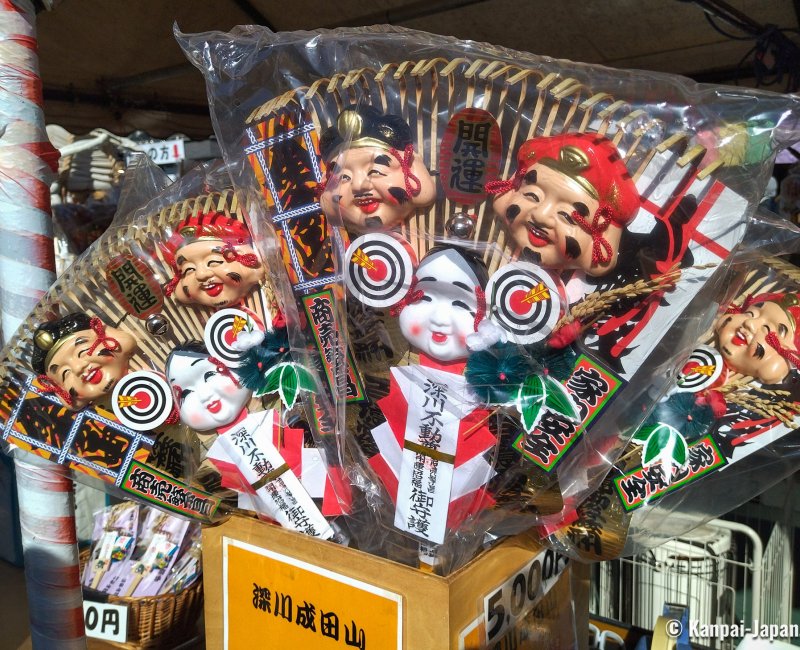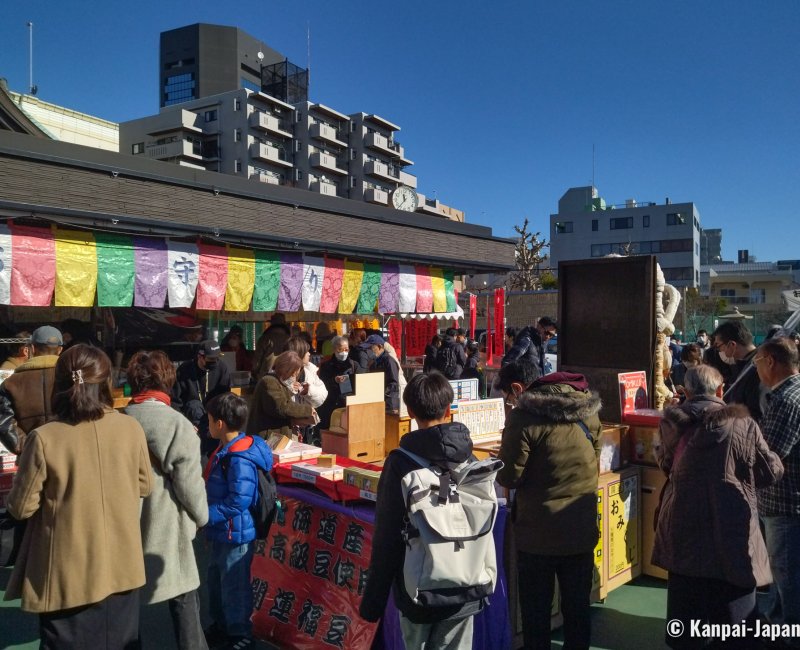Kumade
Raking Prosperity For The Coming Year
Kumade is an ornamental lucky rake that Japanese people buy on the year end hoping for wealth and professional or family good fortune. The rakes are sold during seasonal matsuri hosted by shrines throughout Japan, especially during the Tori no Ichi markets taking place on November’s days of the rooster, especially in Tokyo.
In Japanese, the word 熊手 kumade refers to a rake or a large comb-like tool with hard teeth, used to clean the fallen leaves in parks and gardens. According to its kanji characters transcription, kumade literally means "bear’s hand," which is also a karate term for a move similar to clawing an opponent’s face like a bear paw.
In the Shinto cult, the "ornamental" rake named kazari kumade is a talisman protecting the household and bringing wealth and professional success for the upcoming year. It is therefore sold as a lucky-charm during matsuri festivals hosted by temples and shrines during the year end and the beginning of the year periods: from November’s Tori no Ichi to February 3rd and the celebration of Setsubun, that marks the new year in Japan’s traditional 72 seasons calendar.

The ornamental kumade grew in popularity among the merchants of the Edo period (1603 – 1868) and can reach very expensive prices. After purchase, they are displayed in the shop to ensure good business for its owner. The tradition is to trade up a new and even larger kumade rake every year in order to "rake even more money."
These traditional Shinto objects, often big and colorful, make for a beautiful decoration and show a treasure trove of creativity to attract customers. When a kumade is purchased, a traditional clapping called ippon-jime (一本締め) is performed like so: 3 series of 3 clapping, followed by 1 last clap (3-3-3-1).
The kazari kumade rake is made of bamboo and ornamented with various Japanese lucky-charm symbols, like:
- Japanese gold coins koban;
- Okame goddess’ smiling mask;
- Daruma dolls;
- Maneki-neko beckoning cats;
- Statues of lucky gods Ebisu and Daikokuten associated with good fortune;
- Food offerings (barrels of nihonshu 🍶, bales of rice, etc.);
- Figures of fish (koi carps, sea bream), tsuru cranes, turtles; and,
- Branches of matsu pine tree, bamboo and seasonal flowers typical of Japan.
Tourists can easily find smaller, easier to carry and less expensive rakes: allow from ¥1,000 (~US$6.44) on average for a "pocket" kumade.

Matsuri festivals for good fortune
In Japan, the kazari kumade rakes are on sale every end of the year during matsuri held by shrines related to prosperity. The joyful and friendly atmosphere shapes a lively market where people gather, especially at the end of the day / beginning of the evening and on the weekends to:
- Witness the sale of the most impressive kumade rakes;
- Bring back the past year’s lucky charm and have it incinerated in a purification ritual;
- Purchase a new talisman for the upcoming year; and,
- Enjoy grabbing a snack at the yatai food stalls set up for the occasion.
Tori no Ichi: the day of the rooster in Tokyo
The Japanese capital is known as one of the 1rst places to purchase kumade for the coming year: during Tori no Ichi (酉の市), which is the matsuri of the rooster, a festival particularly popular in Tokyo since the Edo period and in connection with the legendary hero Yamato Takeru no Mikoto.
Each November, during the rooster days (tori no hi) of the Chinese zodiac, Tori no Ichi outdoor markets take place in the city’s Shinto grounds, the main ones being:
- Asakusa and Meguro’s Otori-jinja (大鳥神社) shrines;
- Hanazono-jinja (花園神社) next to Golden Gai in Shinjuku; and,
- Okunitama-jinja (大國魂神社) in Fuchu, in Tokyo’s western suburb.
Tori no Ichi matsuri are also held in:
- Chokoku-ji temple (長國寺), considered the historical birthplace of this celebration, and located near Asakusa’s Otori-jinja; and,
- Local neighborhoods’ old Inari-jinja shrines such as Namiyoke Inari-jinja (波除神社) in the heart of Tsukiji Outer Market and Suga-jinja (須賀神社) in Yotsuya.
There can be 2 or 3 rooster days in November, according to the year. In 2024 (6th year of the Reiwa Era), there were 3 rooster days, namely:

- The 1rst day: Ichi no Tori (一の酉) that took place on November 5;
- The 2nd day: Ni no Tori (二の酉) fell on November 17; and,
- The 3rd day: San no Tori (三の酉) happened on November 29.
Years having 3 rooster days are considered not the best to bring good fortune to the next year and fires 🔥 are particularly dreaded. Therefore, tradition recommends to prefer purchasing a kumade rake at a Tori no Ichi market on one of the 2 first rooster days.
Other festivals pertaining to the New Year
Besides Tokyo and its Tori no Ichi markets in November, various festivals take place in Japan to celebrate the new year. Whether they happen in December or in January, it is possible to buy various traditional lucky charms such as kumade rakes, daruma dolls, ornamental hagoita wooden paddles and hamaya arrows.

The following matsuri are particularly interesting:
- Maebashi Hatsu-ichi Matsuri (前橋初市まつり) that takes place on January 9 on the side of road 50 and at Hachiman-gu shrine in Maebashi city center, in Gunma prefecture in the north-west of Tokyo; and,
- The popular Toka Ebisu (十日戎) festival, from January 9 to January 11 at Imamiya Ebisu-jinja shrine in Osaka.
January 4th in Japan is the 1rst working day of the year, and people often go pay their respect to a shrine close to their workplace. Kanda Myojin in Akihabara for example is visited by many salarymen on this occasion and sells kazari kumade for future prosperity.

